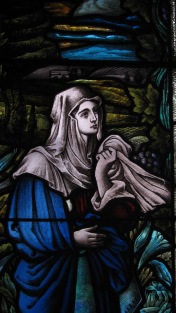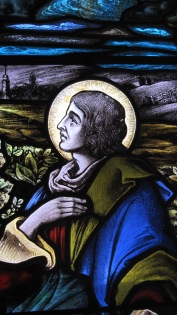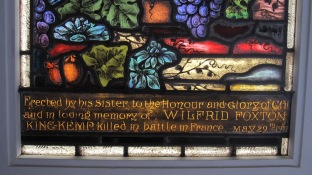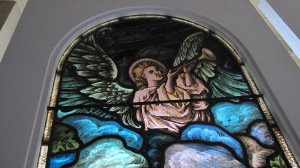

Some time ago I was invited to look at a pair of memorial windows dedicated to two brothers who died in the First World War. They are located in a private home in Melbourne although they were probably installed originally in a church. The current custodian, an artist and collector, has no knowledge of their past history.
The images are details of the full windows.
Although the designer/maker, and the windows’ journey to its present location remain mysteries, quite a lot can be gleaned from the subjects and inscriptions.
The subjects are St. Mary and St. John, which may hold the clue to the original setting. Most commonly these two saints are depicted on either side of the image of the crucified Christ. This suggests that the two windows may originally have been the flanking lights for a central Crucifixion light. In the present setting the two figures face each other, but they are looking up, indicating that the central light was likely to have been taller.
The inscriptions read:
‘Erected by his sister to the Honour and Glory of God and in loving memory of Wilfrid Foxton King-Kemp killed in battle in France, May 29th 1917’ and the other ‘… and in loving memory of Philip Sydney King-Kemp killed in battle in France Oct 19th 1917’.

 Gunner Wilfred Foxton King-Kemp was a 27 year-old solicitor when he enlisted in 1916, aged 27. By May 1916 he was en route for England with 10th Australian Field Artillery Brigade, disembarking at Plymouth two months later. He transferred to the 23rd F.A.B. and proceeded to France in December 1916. His unit was in Belgium when Wilfrid received multiple gun shot wounds to his legs and arms on 10 April 1917. He was evacuated to hospital in Rouen, where he died on 29 May. He was buried at St. Sever Cemetery Extension, Rouen. Added to his family’s distress was information that he was ‘improving’ one day, only to be visited the following day by the local clergyman with the news that he had died.
Gunner Wilfred Foxton King-Kemp was a 27 year-old solicitor when he enlisted in 1916, aged 27. By May 1916 he was en route for England with 10th Australian Field Artillery Brigade, disembarking at Plymouth two months later. He transferred to the 23rd F.A.B. and proceeded to France in December 1916. His unit was in Belgium when Wilfrid received multiple gun shot wounds to his legs and arms on 10 April 1917. He was evacuated to hospital in Rouen, where he died on 29 May. He was buried at St. Sever Cemetery Extension, Rouen. Added to his family’s distress was information that he was ‘improving’ one day, only to be visited the following day by the local clergyman with the news that he had died.
His brother, Driver Philip Gidley King-Kemp also died of wounds only months later. He was a 25 year-old insurance inspector, married to Gertrude Laura, when he enlisted on 10 May 1915. In Egypt by early 1916, he embarked for France, landing at Marseilles on 28 March 1916. He served in several units, and was wounded and gassed in France and Belgium. Serving with the 101st Howitzer Battery, he died from a severe gassing on 18 October 1917. He was buried at Lijssenthoek Military Cemetery, Flanders.
Research, mainly through the wonderful resource of the NLA’s Trove digitised newspapers, shows that there were two other brothers, Warrant Officer G. King-Kemp M.M. and Mr. R.C. King-Kemp of Coraki, a solicitor in 1918, as was their father. There were also five daughters, one of whom donated the windows, but which one is not clear.
Their parents were Richard Edgar Kemp (1849-1927) and Lily Honora, daughter of Archdeacon King, a grandson of the Governor of New South Wales, Philip Gidley King. Richard and Honora were married on 20 May 1877, in St. Luke’s Liverpool, with the bride’s father officiating along with the Headmaster of King’s School, the Rev. G.F. Macarthur.
In 1928, Hilda Sophia King Kemp, youngest of the daughters, was reported to have died on 22 May at 10 Torrington Road, Strathfield. Maybe she was the donor of the windows; research has not yet traced the other sisters. Hilda’s parents pre-deceased her, father Richard in 1927. He was interred at St. Thomas’ Anglican Cemetery, Enfield by the incumbent of St. Paul’s Burwood, assisted by Richard’s brother-in-law, the Rev. C.J. King of Camden. The family’s last home was ‘Gascoigne’, Gordon Street, Burwood.
While it has been possible to trace a part of the civilian and service lives of these two men and their family, the story of the window remains elusive.
The litany of family names and places may give some clue as to where the windows might have been previously located. This Anglican (Church of England) family was very well connected – members of the law fraternity and the clergy pepper family marriages and family names include Macarthur, Macarthur Onslow, Pring, Mullens and Elder as well as Foxton and Gidley King. As successive generations of the family spread throughout country New South Wales and to other eastern States, it is possible that the windows were installed in an Anglican church outside Sydney, but areas around Burwood, Strathfield, Enfield appear to be the most likely sites.
Despite the name of designer/maker remaining unknown, it is likely that the windows were made in the Sydney area. The style has many attributes of F. J. Tarrant & Co., a firm that operated before the First World War until 1946, building windows to designs of freelance artists.
Please add your thoughts, comments and suggestions. One day it may be possible to tell the whole story of these commemorative windows of the First World War.


Most interesting and fitting tribute, Bronwyn, thank you. The key would seem to be finding a lonely crucified Christ dedicated shortly after 1917… clearly the actual Church is no longer extant. I’ll keep an eye out 🙂
LikeLike
Fascinating story and beautiful windows – thanks Bronwyn I hope someone has information to add to the story
LikeLike
Interesting story of two brothers immortalised in stained glass. This also reveals the impact the First World War had on Australia and ways society at the time grieved for this loss, both privately and publically.
LikeLike
Thank you Bronwyn for this research information which hopefully in time will be solved. The two brothers are distant cousins of mine with their father Richard Edgar Kemp being my 2nd great uncle. I am currently researching the family and will get back to you when and if I find more about these beautiful windows. Carmel peek (nee Kemp)
LikeLike